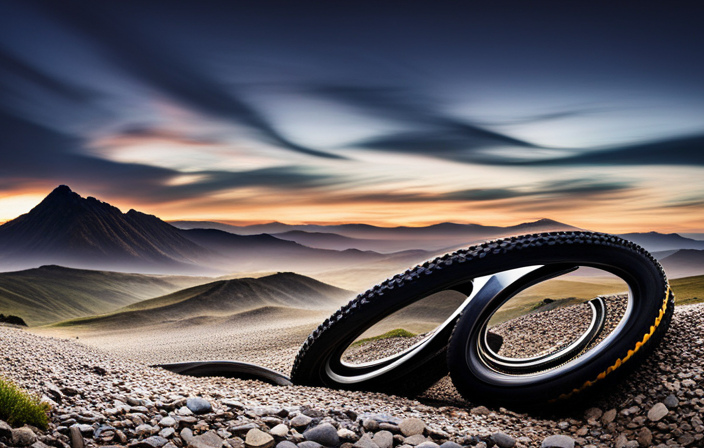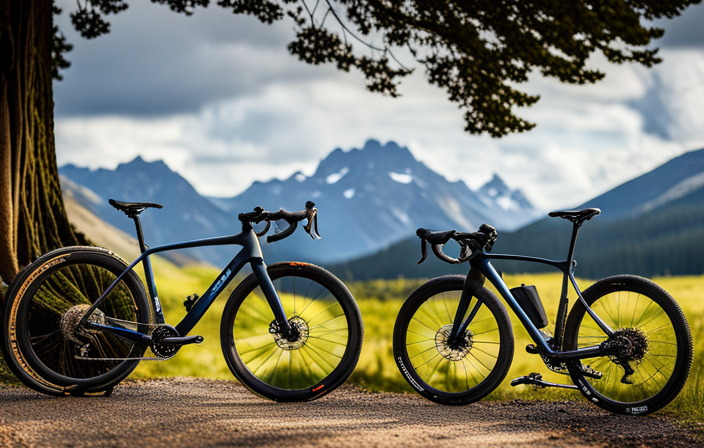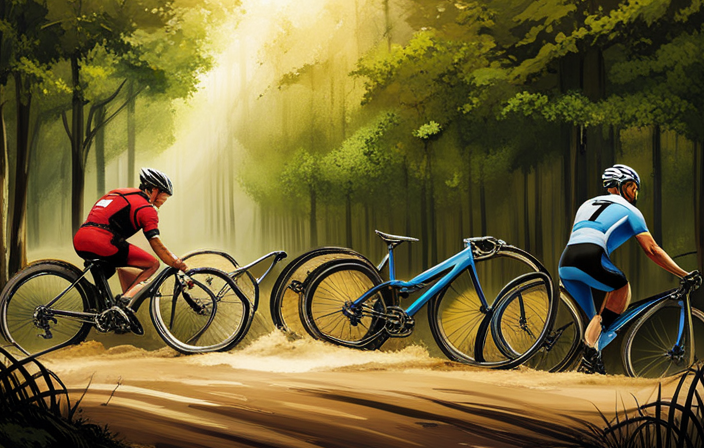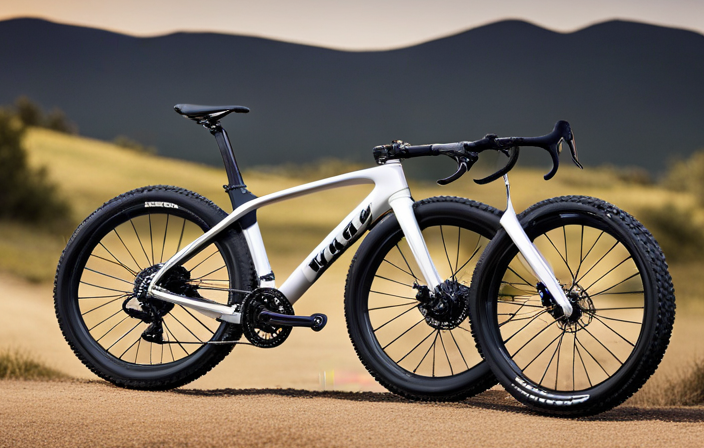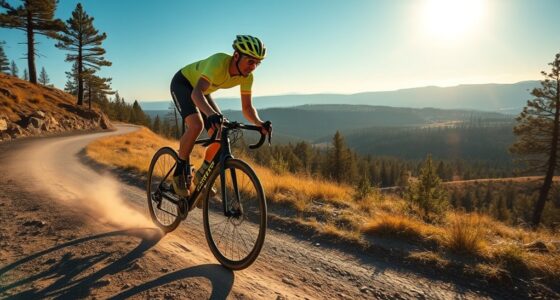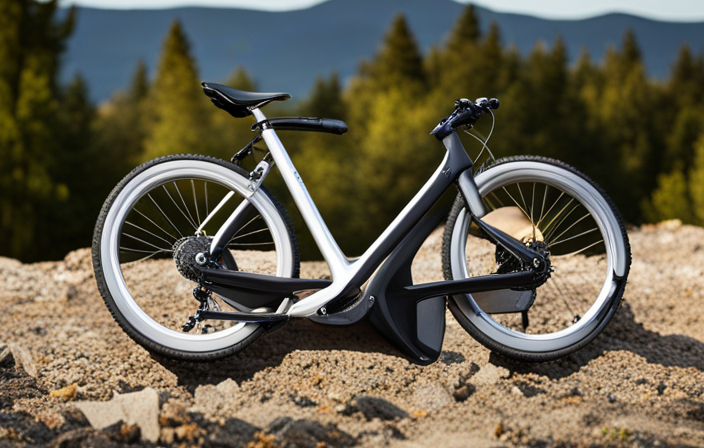Are you prepared to tackle the challenging terrain of loose gravel on your mountain bike? Well, fellow riders, let’s explore the realm of tire pressure and its impact on our performance.
Today, we’ll explore the optimal PSI range for tackling this challenging surface. By understanding the importance of tire pressure and considering various factors, we can determine the ideal PSI that will give us control, stability, and confidence on those unpredictable gravel trails.
So buckle up your helmet and get ready to master loose gravel riding with precision and finesse!
Key Takeaways
- Tire pressure is crucial for mountain biking on loose gravel, as it affects stability and control.
- The recommended range for tire pressure on loose gravel is 25-35 PSI, which provides a balance between grip and rolling resistance.
- Determining the ideal PSI for mountain bike tires on loose gravel depends on factors such as rider weight, bike weight, and riding style.
- Regularly checking and adjusting tire pressure using a gauge is important for improved traction, control, and stability on loose gravel.
Importance of Tire Pressure on Loose Gravel
You should make sure your tire pressure is just right on loose gravel, as it greatly affects your bike’s stability and control. The importance of regular maintenance cannot be stressed enough when it comes to mountain biking. One crucial aspect of this maintenance is maintaining the proper tire pressure.
Riding with the correct psi (pounds per square inch) in your tires not only ensures a smooth and comfortable ride but also maximizes your bike’s performance on loose gravel.
Having the appropriate tire pressure provides several benefits. Firstly, it enhances traction by allowing the tire to conform to the uneven surface of loose gravel, increasing grip and preventing slips or skids. This improves overall control over your bike, especially in challenging terrain where every bit of stability counts.
Secondly, proper tire pressure helps prevent pinch flats or punctures that can occur when the tires are underinflated. By maintaining adequate pressure, you reduce the risk of damaging your inner tubes or rims due to impacts with sharp objects on the trail.
To achieve optimal performance on loose gravel, there are various factors to consider when adjusting tire pressure. These include rider weight, terrain conditions, and personal preference for comfort versus speed. By taking these factors into account and finding the right balance in tire pressure, you can ensure an enjoyable and safe ride through even the most challenging gravel trails without compromising control or stability.
Factors to Consider when Adjusting Tire Pressure
Consider factors such as terrain and surface conditions when adjusting tire pressure on your mountain bike. It’s crucial to understand the importance of tire pressure on loose gravel because it directly impacts your riding experience and performance. Riding with proper tire pressure can provide numerous benefits on loose gravel surfaces.
Here are some factors to consider when adjusting tire pressure for riding on loose gravel:
-
Terrain: The type of terrain you will be riding on plays a significant role in determining the ideal tire pressure. Loose gravel requires a lower psi compared to other terrains like pavement or hard-packed dirt.
-
Surface Conditions: Take into account the current surface conditions, including wet or dry gravel, as this affects traction and stability. Adjusting your tire pressure accordingly can enhance control and prevent slipping.
Maintaining the correct tire pressure on loose gravel offers several advantages, such as improved grip, enhanced traction, and better shock absorption. The optimal tire pressure allows for better maneuverability through corners while reducing the risk of punctures caused by sharp rocks.
Transitioning into the subsequent section about the recommended range for tire pressure on loose gravel will provide further guidance in achieving an ideal setup for your mountain bike.
Recommended Range for Tire Pressure on Loose Gravel
Taking into account the type of terrain and surface conditions, it is important to find the recommended range for tire pressure on loose gravel. Riding on loose gravel can be challenging, but with the right tire pressure, you can enhance your performance and have a smoother ride.
The recommended tire pressure for loose gravel typically falls within the range of 25-35 PSI (pounds per square inch). This range provides a good balance between grip and rolling resistance.
Maintaining proper tire pressure offers several benefits when riding on loose gravel. Firstly, having the correct tire pressure ensures optimal traction. Lower pressures allow the tires to conform better to uneven surfaces, increasing contact area and improving grip. On the other hand, higher pressures reduce rolling resistance, making it easier to maintain speed.
Finding the ideal tire pressure for your mountain bike tires involves experimentation and personal preference. Factors such as rider weight, bike weight, and riding style also come into play when determining PSI. In the next section, we will explore how to determine the ideal PSI for your mountain bike tires without compromising performance or safety.
How to Determine the Ideal PSI for Your Mountain Bike Tires
To find the ideal PSI for your mountain bike tires, it’s important to consider factors such as rider weight, bike weight, and riding style. Determining the optimal psi for different terrains is crucial in enhancing your biking experience and performance. Understanding the effects of tire pressure on performance can help you make informed decisions.
Here are some key points to keep in mind when determining the ideal PSI for your mountain bike tires:
- Rider Weight: A heavier rider may require higher tire pressure to prevent pinch flats, while a lighter rider might benefit from lower pressure for better traction.
- Bike Weight: If you have a heavier bike or are carrying extra gear, slightly higher tire pressure can provide added support and stability.
- Riding Style: Aggressive riders who tackle rough terrains may want higher tire pressure for faster rolling speed, whereas more cautious riders might prefer lower pressure for increased grip.
Finding the right tire pressure is a balancing act that requires experimentation. It’s essential to start with recommended PSI ranges provided by the manufacturer and then adjust based on personal preference and terrain conditions.
Next, let’s explore some tips for checking and adjusting tire pressure without compromising your biking experience.
Tips for Checking and Adjusting Tire Pressure
Start by using a tire pressure gauge to check the PSI of your mountain bike tires. This simple tool is essential for maintaining optimal tire pressure. To ensure accurate readings, remove the valve cap and press the gauge firmly onto the valve stem. The gauge will display the current PSI of your tires. Once you have this information, you can determine if your tires need to be adjusted.
When checking and adjusting tire pressure, there are a few techniques you can use. One method is to inflate your tires to their maximum recommended PSI, then slowly release air until you reach the desired pressure within the recommended range. Another approach is to start with a lower PSI and gradually increase it until you find the right balance between grip and rolling resistance on loose gravel.
The recommended psi range for mountain bike tires on loose gravel typically falls between 30-50 PSI, depending on factors such as rider weight and tire width. It’s important to find what works best for you through trial and error. Proper tire pressure ensures improved traction, control, and stability on rough terrain like loose gravel.
By understanding how to check and adjust your tire pressure effectively, you’ll be able to experience the benefits of proper tire pressure on loose gravel in no time.
Benefits of Proper Tire Pressure on Loose Gravel
Proper tire pressure on loose gravel provides improved traction, control, and stability. When riding on loose gravel, it is important to adjust your tire pressure accordingly for optimal performance. Lowering the tire pressure can offer several benefits in this type of terrain.
One of the main advantages of lowering the tire pressure on loose gravel is increased traction. The lower pressure allows the tires to conform better to the uneven surface, creating a larger contact patch with the ground. This increased contact area enhances grip and helps prevent slippage while navigating through loose gravel.
In addition to improved traction, lower tire pressure also enhances control. With reduced air pressure, the tires become more compliant and absorbent over rough terrain. This translates into a smoother ride and better handling as you tackle obstacles such as rocks or roots on loose gravel trails.
However, it is important to find a balance when adjusting your tire pressure. Going too low can result in decreased stability and an increased risk of flats or rim damage. It’s crucial to find the right psi that offers enough cushioning without compromising overall performance.
Lowering your tire pressure on loose gravel can greatly benefit your ride by improving traction and control. However, it’s essential to be aware of potential risks associated with incorrect pressures – we will explore these further in the next section about ‘potential risks of incorrect tire pressure on loose gravel.’
Potential Risks of Incorrect Tire Pressure on Loose Gravel
One of the risks of incorrect tire pressure on loose gravel is a higher chance of losing control. When your tire pressure is too low, the tires have a larger contact patch with the ground, which can lead to increased rolling resistance and decreased stability. This means that your bike may feel wobbly and less responsive when navigating through loose gravel.
To illustrate the potential risks and benefits of proper tire pressure on loose gravel, let’s take a look at the following table:
| Risks of Underinflated Tires | Benefits of Proper Tire Pressure |
|---|---|
| Increased rolling resistance | Improved traction |
| Decreased stability | Enhanced maneuverability |
| Higher risk of flats | Better shock absorption |
Underinflated tires increase rolling resistance, making it harder to pedal efficiently on loose gravel. They also decrease stability, making it more difficult to maintain control over your bike. Additionally, underinflated tires are more prone to flats as they are more susceptible to punctures from sharp rocks or debris.
On the other hand, having proper tire pressure offers several benefits. It improves traction by allowing the tread pattern to grip the surface effectively. This enhances maneuverability, enabling you to navigate corners and obstacles with greater confidence. Moreover, properly inflated tires provide better shock absorption, reducing vibrations and improving overall comfort during your ride.
Understanding these risks and benefits can help you make informed decisions about maintaining optimal tire pressure for riding on loose gravel. Now let’s explore additional techniques for riding on loose gravel without compromising safety or performance in the subsequent section.
Additional Techniques for Riding on Loose Gravel
To ride safely on loose gravel, remember to maintain a steady speed and keep your body relaxed. In addition to these basic techniques, there are some additional techniques that can help you navigate through this challenging terrain.
One of the key techniques is weight distribution. By shifting your weight backward, you can improve traction on the rear wheel and prevent it from sliding out. This is especially important when going downhill or taking sharp turns on loose gravel.
Another technique is using your brakes effectively. Instead of squeezing the brakes abruptly, try modulating them gradually to avoid skidding or losing control. It’s also helpful to use both brakes simultaneously for better stability.
Advanced riding skills such as controlled slides and drifts can be useful on loose gravel as well. These techniques allow you to maintain control while cornering at higher speeds by intentionally breaking traction momentarily.
Remember that mastering these techniques takes practice and experience. Start by practicing in a safe environment with low traffic and gradually increase difficulty as you become more confident.
By incorporating these additional techniques into your riding repertoire, you will be better equipped to handle loose gravel with confidence and control. Now let’s transition into discussing the importance of regular maintenance and inspection without missing a beat!
Importance of Regular Maintenance and Inspection
When it comes to regular maintenance and inspection, there are three key points that I always keep in mind.
First, it is crucial to check for any signs of wear and tear on my tires. This includes looking out for any cracks, bulges, or uneven tread patterns that can affect the performance and safety of my ride.
Secondly, ensuring proper rim tape and tubeless sealant is essential to prevent any air leaks or punctures while riding on various terrains.
Lastly, I always monitor and adjust my tire pressure as needed depending on the conditions I will be riding in. This helps me maintain optimal traction and control over my mountain bike.
Check for Wear and Tear on Tires
Inspect your mountain bike tires for any signs of wear and tear. Checking the tread depth is crucial as it directly affects traction on loose gravel. A worn-out tread will result in less grip, making it harder to maintain control on uneven surfaces.
Look for signs of sidewall damage, such as cuts or bulges, which can lead to tire failure and potential accidents. Additionally, check for any embedded objects like thorns or shards that could cause punctures.
Regularly inspecting and replacing damaged tires will ensure optimal performance and safety while riding off-road.
Once you have ensured the integrity of your tires, it’s important to move on to the next step: ensuring proper rim tape and tubeless sealant for a seamless ride over loose terrain.
Ensure Proper Rim Tape and Tubeless Sealant
Make sure you have the right rim tape and tubeless sealant for a smooth ride on uneven surfaces. The importance of proper rim tape cannot be overstated when it comes to mountain biking on loose gravel. It acts as a barrier between the tire and the rim, preventing punctures and air leaks. Without it, you risk damaging your tires and compromising your safety.
Additionally, tubeless sealant is crucial in preventing flats caused by small punctures. It fills any holes or cuts in the tire, sealing them instantly upon contact with air. However, it’s important to note that even with the best tape and sealant, issues can still arise. Troubleshooting common tubeless issues like burping or leaking requires careful inspection and adjustment of both tape and sealant.
By ensuring you have the right products and troubleshooting any problems that arise, you’ll be well-prepared for a successful ride on loose gravel terrain.
Now let’s move on to how to monitor and adjust tire pressure as needed…
Monitor and Adjust Tire Pressure as Needed
To ensure a smooth ride on uneven surfaces, it’s important to regularly check and adjust tire pressure as needed. Maintaining the correct tire pressure is crucial for optimal performance and safety while riding on loose gravel. Here are some key reasons why regular maintenance and inspection of tire pressure is essential:
-
Improved traction: Proper tire pressure ensures maximum contact between the tires and the ground, enhancing grip on loose gravel.
-
Enhanced stability: Correct tire pressure helps maintain stability and control, reducing the risk of skidding or sliding on unpredictable surfaces.
-
Prevents flats: Monitoring and adjusting tire pressure can help prevent pinch flats or punctures caused by excessive pressure or low psi.
-
Comfortable ride: By finding the right balance between stiffness and absorption, proper tire pressure provides a more comfortable experience when encountering rough terrain.
Before tackling different types of loose gravel surfaces, it’s crucial to ensure your tires are properly inflated.
How to Handle Different Types of Loose Gravel Surfaces
When riding on loose gravel surfaces, it is important to adjust the psi of your mountain bike tires to ensure optimal traction and stability. Different types of loose gravel surfaces require different techniques to handle them effectively.
For instance, when riding on small, loose gravel, it is important to maintain a balanced body position and distribute your weight evenly on both wheels. This will help prevent your tires from sinking into the gravel and losing traction.
On larger, chunkier gravel surfaces, a slightly lower tire pressure can provide better grip. The increased contact patch between the tire and the ground allows for more traction and control. However, be cautious not to reduce the pressure too much as it may result in pinch flats or rim damage.
To handle loose gravel surfaces confidently, having recommended gear such as wider tires with aggressive treads can greatly enhance your performance. These tires provide better grip and stability on unpredictable terrain.
It is crucial to remember that safety precautions and protective gear are essential when riding on any surface. Wearing a helmet, knee pads, elbow pads, and appropriate footwear can protect you from potential injuries in case of falls or accidents.
Transitioning into the next section about safety precautions and protective gear: Ensuring you have these safety measures in place will allow you to fully enjoy your ride while minimizing any risks involved.
Safety Precautions and Protective Gear
When it comes to riding on loose gravel surfaces, safety should always be a top priority. As we discussed in the previous subtopic, knowing how to handle different types of loose gravel surfaces is crucial for maintaining control and stability. However, even with the right techniques, accidents can still happen. That’s why it’s important to take proper safety precautions and wear protective gear.
One essential piece of protective gear is choosing the right helmet. A properly fitted helmet can greatly reduce the risk of head injuries in case of a fall or collision. Look for a helmet that meets safety standards and provides adequate protection for mountain biking.
In addition to a helmet, knee and elbow pads are also important for protecting your joints from impact injuries. These pads not only provide cushioning but also help prevent cuts and abrasions when sliding or falling on rough gravel surfaces.
By wearing the appropriate protective gear, you can minimize the risk of serious injury while riding on loose gravel. Now that we’ve covered safety precautions and protective gear, let’s move on to expert advice and recommendations for optimizing your mountain bike performance on these challenging surfaces without compromising safety.
Expert Advice and Recommendations
For optimal performance and safety on challenging surfaces, it’s important to follow expert advice and recommendations.
When it comes to riding on loose gravel with your mountain bike, there are a few key factors to consider. First and foremost, the importance of professional bike fitting cannot be overstated. Ensuring that your bike is properly fitted to your body will not only enhance comfort but also maximize power transfer and control.
One of the most significant recommendations from experts when riding on loose gravel is to invest in tubeless tires. The benefits of tubeless tires on this type of terrain are numerous. They provide a lower tire pressure option without risking pinch flats or punctures, allowing for better traction and grip on unpredictable surfaces like loose gravel.
To summarize the expert advice and recommendations for riding on loose gravel:
- Get a professional bike fitting for optimal comfort, power transfer, and control.
- Invest in tubeless tires to take advantage of lower tire pressures while avoiding flats or punctures.
- Consider wider tires for increased stability and improved handling on loose surfaces.
By following these recommendations, you can greatly enhance your riding experience on loose gravel.
Now let’s transition into the next section where we’ll delve into real-life experiences and riding stories without missing a beat.
Real-life Experiences and Riding Stories
Transitioning into real-life experiences and riding stories, it’s fascinating to hear how riders have tackled different terrains and overcome challenges. When it comes to loose gravel, riding techniques play a vital role in maintaining control and stability. I’ve found that keeping my weight back on the bike helps to prevent the front tire from washing out. This technique allows for better traction and maneuverability. Additionally, using wider tires with aggressive tread patterns provides increased grip on loose surfaces.
One of the best tires I’ve used for riding on loose gravel is the Maxxis Minion DHF. Its wide profile and sturdy knobs provide excellent traction, allowing me to confidently navigate through gravelly sections without losing control. Another popular choice among riders is the Schwalbe Hans Dampf, known for its versatility and ability to handle various terrains.
Real-life experiences have taught me that finding the right tire pressure is crucial when riding on loose gravel. Lowering your tire pressure slightly can increase contact patch size, providing more grip on loose surfaces. However, be cautious not to go too low as it may result in pinch flats or rim damage.
Transitioning into our next section about common questions regarding tire pressure on loose gravel, let’s explore some FAQs riders often encounter when trying to achieve optimal performance on this challenging terrain.
FAQ: Common Questions about Tire Pressure on Loose Gravel
If you’re looking for answers to common questions about tire pressure on loose gravel, let’s dive into some FAQs riders often encounter when trying to achieve optimal performance on this challenging terrain. One of the most important factors in maintaining control and stability on loose gravel is maintaining the right tire pressure. Many riders mistakenly believe that lower tire pressure will provide better traction on loose surfaces. However, this is a common misconception. In reality, running too low of a psi can lead to increased rolling resistance and an increased risk of pinch flats.
To help you understand the importance of maintaining tire pressure and dispel some misconceptions, here are answers to frequently asked questions:
| Low Tire Pressure | High Tire Pressure | Optimal Tire Pressure | |
|---|---|---|---|
| Handling | Decreased stability | Harsh ride quality | Improved control |
| Traction | Reduced grip | Increased slipping | Enhanced traction |
| Rolling Resistance | Higher drag | Lower rolling resistance | Balanced performance |
| Puncture Resistance | Increased risk of pinch flats | Reduced risk | Optimal protection |
| Cornering Ability | Impacted maneuverability | Better cornering precision | Enhanced agility |
By understanding these factors and finding the optimal tire pressure for your bike, you can maximize your performance on loose gravel. With proper knowledge and maintenance, mastering loose gravel riding with proper tire pressure becomes attainable.
Conclusion: Mastering Loose Gravel Riding with Proper Tire Pressure
To truly master riding on loose gravel, it’s crucial to understand the importance of maintaining proper tire pressure. The right tire pressure can greatly affect your performance and control on this challenging terrain. One key aspect to consider is mastering cornering techniques.
When riding on loose gravel, it’s essential to have a lower tire pressure than usual. This allows the tires to conform to the uneven surface and provide better traction while turning. A lower tire pressure also helps absorb some of the impact from bumps and rocks, making your ride more comfortable and stable.
In addition to tire pressure, choosing the right tire tread is equally important for tackling loose gravel. Look for tires that have larger knobs or lugs with wider spacing between them. These features help dig into the loose surface, providing better grip and preventing slippage during acceleration or braking maneuvers.
Remember, finding the perfect balance for your tire pressure can be a bit of a trial and error process. Start by lowering your psi slightly below what you normally use on other surfaces and test how it feels on loose gravel. Adjust accordingly until you find the sweet spot that offers optimal performance and control.
By mastering cornering techniques and choosing the right tire tread, along with maintaining proper tire pressure, you’ll be well-equipped to handle any challenges that come with riding on loose gravel. So go out there, explore those off-road trails with confidence!
Frequently Asked Questions
Can I use the same tire pressure on loose gravel as I do on paved roads?
Using the same tire pressure on loose gravel as on paved roads has both pros and cons.
Lower tire pressure can provide better traction and stability on loose surfaces, improving control. However, it can also increase rolling resistance and make pedaling more difficult.
To maintain balance and control with different tire pressures on loose gravel, it’s important to adjust your body position and weight distribution accordingly.
Additionally, consider using wider tires for improved stability and lower pressures for enhanced grip.
How often should I check and adjust my tire pressure for riding on loose gravel?
I always make sure to regularly check my tire pressure for general mountain biking. It’s crucial to maintain the optimal tire pressure for different terrains.
Adjusting your tire pressure properly can greatly improve your ride on loose gravel, providing better traction and control.
To ensure peak performance, I recommend checking your tire pressure before each ride and making adjustments as necessary. This will help maximize your enjoyment and safety on the trails.
Are there any specific tire brands or models that are recommended for riding on loose gravel?
When it comes to riding on loose gravel, choosing the right tire tread is crucial. There are several recommended tire brands known for their performance on this terrain. Look for tires with aggressive knobs and wide spacing between them to provide better traction and control.
Some popular options include Maxxis Minion DHF, Schwalbe Nobby Nic, and Continental Mountain King. Consider factors like durability, rolling resistance, and grip when selecting your ideal tire for riding on loose gravel.
What are the potential consequences of using incorrect tire pressure on loose gravel?
Using incorrect tire pressure on loose gravel can have potential dangers and a significant impact on traction.
I once rode my mountain bike with overinflated tires on loose gravel, and it felt like riding on marbles. The lack of grip caused me to lose control, resulting in a nasty fall.
Similarly, underinflated tires can sink into the gravel, reducing stability and making it harder to navigate rough terrain.
It is crucial to find the right tire pressure for optimal traction and safety on loose gravel surfaces.
Can I use a tire pressure gauge to accurately determine the ideal PSI for my mountain bike tires on loose gravel?
Yes, a tire pressure gauge can provide accurate readings for determining the ideal psi of mountain bike tires on loose gravel.
However, it’s important to consider several factors that may affect the accuracy of the gauge.
These factors include temperature changes, tire type and width, rider weight, and terrain conditions.
It’s recommended to consult with a professional or refer to manufacturer guidelines for precise psi recommendations based on these variables.
Conclusion
So there you have it, fellow riders. Mastering loose gravel riding comes down to one key factor: proper tire pressure.
By adjusting your mountain bike tires to the recommended range for loose gravel, you’ll experience improved traction and control on those challenging surfaces.
Remember to take into account factors like rider weight, tire width, and trail conditions when determining the ideal PSI for your tires.
And don’t forget to regularly check and adjust your tire pressure for optimal performance.
With these tips and expert advice, you’ll conquer any loose gravel trail with confidence and ease.
Happy riding!
